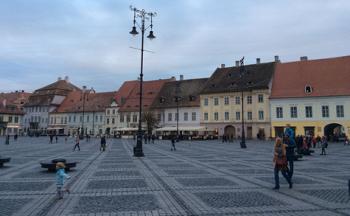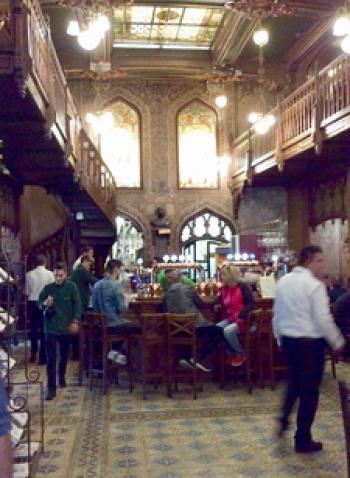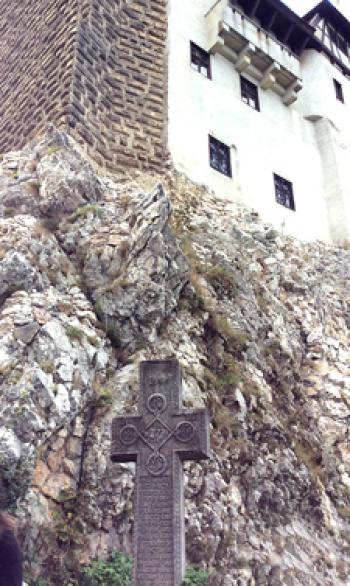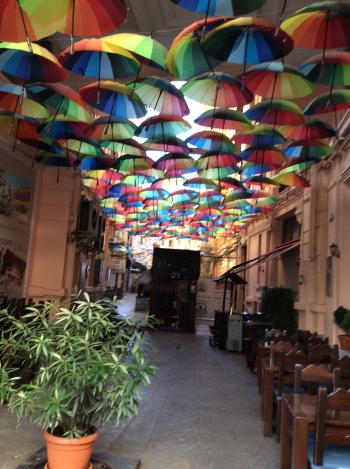Quest for pastrama in Romania
This item appears on page 12 of the August 2019 issue.
A Balkan tour that we took in September 2018 covered several countries, each one fascinating in its own way, but our final 3-day stop in Romania had a personal dimension: a quest to find authentic pastrami, said to have started in Romania as “pastrama.”
History tells us that when Romanian Jews fled repression in the 19th and early 20th centuries, they brought little more than traditions with them, one of which was the age-old method of preserving meat with a brine made of salt, sugar and pickling spices of mostly peppercorns and coriander.
Though recipes vary, the meat is then usually smoked, dried and roasted again with more peppercorns, coriander and other spices. In Romania, this preparation was used on any meat and even fish, but it was most often used on lamb, the most common meat.
When Romanian Jews moved to the US, many settled in New York. Here they replaced lamb with beef brisket as the favored meat, which was often eaten in a rye-bread sandwich, creating the deli style of takeout and eating on the run.
The name shifted from pastrama to pastrami, probably just from regional differences of pronunciation. Eventually, pastrami became synonymous with cured beef brisket rather than the method of preparation.
Pastrami is my husband, Richard’s, favorite food, so being able to eat pastrama was a highlight of our Balkan trip.
• It was late afternoon when we arrived by car in Bucharest, Romania’s capital. Our guide and driver, Thomas, had been with us for two weeks. After checking into our hotel, we headed for Hanu’ lui Manuc, or Manuc’s Inn (Strada Franceza 62, Bucharest; www.hanumanucrestaurant.ro/en), a restaurant rated in the guidebooks as one of the best.
This 2-story establishment has a vast outdoor patio with ample seating for over a hundred people. The upstairs is equally large.
Unfortunately for us, this was the first cool day of our trip, and a large party had reserved the entire upstairs. After some pleading on our part, the hostess managed to find and set a small table for us in the corner. A 3-piece band played Romanian folk songs as we fervently perused the menu for their “pastrama” choices.
Rather than a sandwich, our first pastrama of the trip was large chunks of lamb brined in spices, then smoked and roasted. The lamb looked dry, but the meat was tender, smoky and moist. Portions were ample, but we ate every last morsel.
The mountain of mămăligă (polenta) that accompanied the pastrama, although tasty, almost defeated us. If we had been in New York, I would have taken some home for breakfast.
• The next day started early with a long, fascinating tour of Old Town and some remarkable buildings (testaments to Romania’s grim recent past), with stops in a pedestrian area and a nice café, but we were saving up for the main event.
In the early afternoon, we went to Caru’ cu Bere, or The Beer Wagon (Strada Stavropoleos 5, Bucharest), the oldest restaurant and perhaps the most famous in the city.
Vast, imposing and 2-storied, the restaurant still seemed cozy and intimate, having been divided into smaller rooms with carved-wood arches, painted walls and low ceilings, each room overlooking the immense middle hall, where a band played popular tunes.
It was filled to capacity yet not too noisy. The service and other customers were friendly, and one couple toasted us when we both had the same pastrama platter. Again, the pastrama was lamb, but this time it was accompanied by pork and sausage. The sausages did not seem brined. The mound of mămăligă was massive and a bit creamy.
• Like all big cities, Bucharest is plagued with traffic jams, and we experienced one of the worst there. Eventually, Thomas got us on the highway headed for Bran Castle (also known as Dracula’s Castle) in the Transylvania region.
In Bran, we had lunch at a sort of fast-food restaurant, Galeria Bran (Strada General Traian Mosoiu 499, Bran). The upstairs had an amusing treehouse effect but was a bit gloomy, so we opted for the enclosed downstairs deck. We would stay only if pastrama was on the menu, and it was. (We decided that pastrama in Romania is like hamburgers in the US.)
The lamb pastrama came in small pieces. It was edible, not tough, yet not brined and spiced enough — no comparison with that of Hanu’ lui Manuc or Caru’ cu Bere but slightly cheaper, and it came with lots of mămăligă.
• Next we took a long drive on a smooth highway through Transylvania along the Carpathians, a mountain range of spectacular beauty.
Our destination was Sibiu, a charming small town with a large central plaza perfect for walking and lingering. Our real aim, though, was Crama Sibiul Vechi, or Old Sibiu Cellar (Strada A. Papiu Ilarian 3; www.sibiulvechi.ro/en), a restaurant highly recommended in guidebooks.
It was, indeed, in a cellar — long and narrow, with brick-vaulted ceiling and walls — but the atmosphere was warm and convivial. A duo was playing and singing folk songs. We got the last table.
We had both lamb and pork pastrama. Each came in two large chunks and was nicely spiced. The mămăligă was abundant.
For this quest, we ate in the best restaurants we knew of. With tips, our bills ranged from $25 to $28 for two, each meal including a carafe of house wine, two appetizers, two main dishes and sometimes coffee.
We also partook of ajvar (red pepper puree), rich bean stews, fresh salads and good Romanian wines. A wide range of wines could be had at higher prices. The coffee, whether espresso or Americano, was always excellent.
We never had room for dessert, but on other tables we saw chocolate cakes, cheesecakes, plum dumplings and apple strudels that looked delectable.
My husband and I now see pastrami in a new light. Also, I better understand my fondness for smoked-salmon pastrami. I used to think it was a fusion fad, like pastrami kimchi, but now I think that dish is rooted in tradition.
Davor Miškić, owner of ZagrebTours (Lopasiceva 120, 10000 Zagreb, Croatia; phone +385 99 4825 035, www.zagrebtours.com/en), and our guide/driver, Tomislav (Thomas) Rajtaric (tomo.rajtaric@gmail.com; phone +385 91 1904 707), made the arrangements for our Balkan tour that enabled us to achieve our quest (July ’19, pg. 26).
KITTY CHEN DEAN
New York, NY




